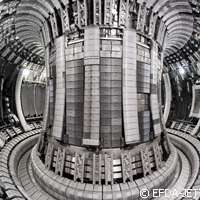World's largest fusion device goes back to work

September is commonly the month where things begin to gather pace again, and in the world of fusion energy research, things are no different. European scientists working on the Joint European Torus (JET), the world's largest magnetic confinement fusion device, are about to embark on the first round of experiments following a 22-month period where the device was out of action whilst being upgraded and commissioned.
JET's researchers are investigating the potential of fusion power as a safe, clean, and virtually limitless energy source for future generations. The research is coordinated under the European Fusion Development Agreement (EFDA), signed by all 27 Member States as well as Switzerland. The JET project forms part of the preparatory stages leading to preparation for International Thermonuclear Experimental Reactor (ITER) operation.
ITER, funded in part by the European Commission as part of the 'Fusion energy research' Theme of the Seventh Framework Programme (FP7) under the Treaty of the European Atomic Energy Community (Euratom), is an international research and engineering project currently building the world's largest and most advanced experimental tokamak nuclear fusion reactor in Cadarache, France. The ITER project aims to make the transition from the study of plasma physics to building full-scale electricity-producing fusion power plants.
Fusion power is the attempt to mirror the process of energy release when light atomic nuclei fuse together to form heavier atoms. This process takes place in stars; scientists hope that it can be replicated in fusion power plants on Earth. In a fusion reactor, nuclei of hydrogen isotopes, deuterium and tritium fuse at high temperatures and produce helium and high-energy neutrons. A commercial power station would use the heat generated by the neutrons when slowed down by denser material, to generate electricity. In addition, fusion reactions take place when temperatures exceed 100 million degrees.
Scientists claim the fusion power process produces no greenhouse gases or long-lived radioactive waste.
JET, which is kept at the Culham Centre for Fusion Energy in the United Kingdom, is the only machine capable of operating with the deuterium-tritium fuel mixture that will be used in ITER and commercial fusion power stations.
During JET's extended leave of absence from experiments, it was equipped with a completely new 'ITER-Like Wall', and it will be the first fusion machine to test materials that will be used as part of ITER. Scientists removed and replaced approximately 86,000 components, largely using remote handling technology. The inside of the vessel is now made up of beryllium and tungsten tiles. Beryllium is being used in the main wall, whereas tungsten, with its high melting point, is being used for the exhaust component known as the 'diverter' that has to withstand high heat flux.
Lorne Horton, head of EFDA's JET Department, comments: 'The coming experiments will aim to verify that the wall materials chosen for ITER will behave as expected.'
EFDA Leader Francesco Romanelli comments on the JET upgrade work: 'This is probably the largest effort that has been put into JET apart from the construction of the machine itself. With the expertise and contribution of many fusion laboratories, the JET team has succeeded in building a small ITER. We had a very good start with high purity plasmas readily established in ITER relevant conditions - a promising sign for the use of these wall materials in ITER.'
The other improvement carried out during this veritable 'fusion MOT' is a 50 % increase in the heating power. With the extra power, JET will achieve higher plasma temperatures and approach ITER conditions. New diagnostics and control systems, developed by the EFDA associate laboratories, will allow for deeper investigation into the scientific challenges ahead in ITER.
Maximos Tsalas, a scientist who previously worked on the JET project, was in the control room on 24 August as scientists gathered to watch the grand unveiling of JET since its upgrade and to see whether it would produce its first plasma since the installation of the new ITER-Like Wall. "I left JET more than a year ago. Coming back, the developments I see are amazing. JET has become a brand new machine. I feel extremely privileged to take part in the first set of experiments. The coming campaign will be very challenging, and we are all eager to see how the new systems perform and to learn how to operate with the new wall. JET will be progressively brought up to full power to allow a proper investigation of the ITER materials under conditions approaching those of ITER," he comments.
Remarkably, the first plasma with the new ITER-Like Wall lasted 15 seconds - much to the surprise of scientists. Peter Lomas, Head of Plasma Operations, comments: "We got plasma with no impurities and we got it on the first attempt. We were prepared to struggle, but we just did what we normally do with the old carbon wall. And that is the surprise."
Guy Matthews, leader of the ITER-Like Wall project, says: "Our first impression from spectroscopy is that the plasma was very clean. We got a really impressive result, given the large volume of new components."
More information: JET: www.jet.efda.org/
Provided by CORDIS


















